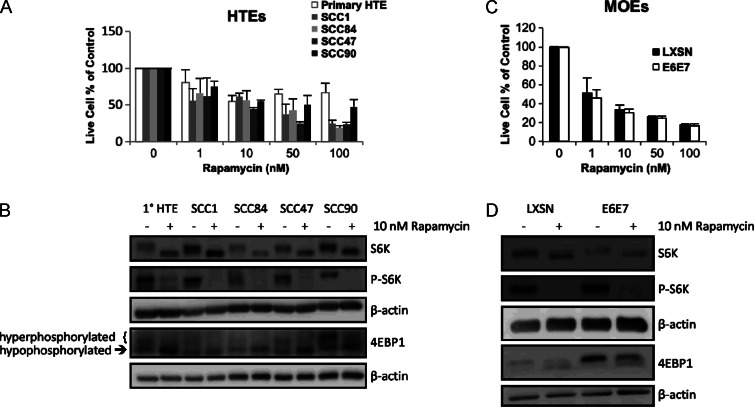Figure 1.
Inhibition of cell proliferation of human and mouse HNSCC cell lines by rapamycin is associated with decreases in mTOR signaling. (A) Cell proliferation assay. Primary HTEs are compared to four tonsillar SCC lines, two HPV- (SCC1 and SCC84) and two HPV+ (SCC47 and SCC90), after 72 hours of rapamycin treatment at the indicated concentrations. (B) Western blot analysis of downstream targets of mTOR. Whole-cell lysates of the cell lines described in A after 24 hours of 10 nM rapamycin treatment were analyzed for protein levels downstream of mTOR. (C) Mouse correlate to A. A retrovirally transduced and immortalized HPV+ mouse oropharyngeal epithelial (MOE) cell line possessing the E6 and E7 oncogenes (E6/E7) is compared to an empty vector containing control line (LXSN). (D) Corresponding mouse correlate Western blots of downstream targets of mTOR. All cell lines treated with rapamycin showed a dose-dependent decrease in cell proliferation (all lines at 10–100 nM rapamycin, P ≤ .047 to control). Regarding Western blots, with rapamycin treatment, total S6K migrates slightly faster, indicating dephosphorylation. Phosphorylation of S6K (P-S6K) is nearly completely inhibited, and 4EBP1 shows decreases in the slower migrating, hyperphosphorylated bands and increases in the faster migrating, hypophosphorylated bands. Blots have been cropped for presentation and those with dark backgrounds have been enhanced in contrast and brightness in entirety using Microsoft PowerPoint before cropping. Full-length blots can be seen in Figure W1.

